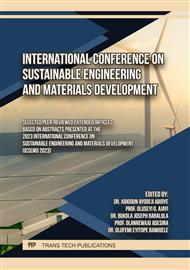[1]
J. Eastman, U. S. Choi, S. Li, L. J. Thompson and S. Lee, Enhanced Thermal Conductivity Through the Development of Nanofluids, MRS Proceedings vol. 457 (1996).
DOI: 10.1557/proc-457-3
Google Scholar
[2]
M. Osama, A. Singh, R. Walvekar, M. Khalid, T. C. S. M. Gupta and W. W. Yin, Recent developments and performance review of metal working fluids, Tribol. Int. 114 (2017) 389–401.
DOI: 10.1016/j.triboint.2017.04.050
Google Scholar
[3]
K. S. Suganthi and K. S. Rajan, Metal oxide nanofluids: Review of formulation, thermo-physical properties, mechanisms, and heat transfer performance, Renew. Sustain. Energy Rev. 76 (2017) 226–255.
DOI: 10.1016/j.rser.2017.03.043
Google Scholar
[4]
A. Borode, N. Ahmed and P. Olubambi, A review of solar collectors using carbon-based nanofluids, J. Clean. Prod. 241 (2019) 118311.
DOI: 10.1016/j.jclepro.2019.118311
Google Scholar
[5]
A. Ijam, R. Saidur, P. Ganesan and A. Moradi Golsheikh, Stability, thermo-physical properties, and electrical conductivity of graphene oxide-deionized water/ethylene glycol based nanofluid, Int. J. Heat Mass Transf. 87 (2015) 92–103.
DOI: 10.1016/j.ijheatmasstransfer.2015.02.060
Google Scholar
[6]
P. G. Kumar, V. Kumaresan and R. Velraj, Stability, viscosity, thermal conductivity, and electrical conductivity enhancement of multi-walled carbon nanotube nanofluid using gum arabic, https://doi.org/10.1080/1536383X.2017.1283615 25 (2017) 230–240.
DOI: 10.1080/1536383x.2017.1283615
Google Scholar
[7]
A.A. Minea and R.S. Luciu, Investigations on electrical conductivity of stabilized water based Al2O3 nanofluids, Microfluid. Nanofluidics 2012 136 13 (2012) 977–985.
DOI: 10.1007/s10404-012-1017-4
Google Scholar
[8]
A.O. Borode, N.A. Ahmed, P. A. Olubambi, M. Sharifpur and J. P. Meyer, Effect of Various Surfactants on the Viscosity, Thermal and Electrical Conductivity of Graphene Nanoplatelets Nanofluid, Int. J. Thermophys. 42 (2021) 158.
DOI: 10.1007/s10765-021-02914-w
Google Scholar
[9]
G. Huminic and A. Huminic, Hybrid nanofluids for heat transfer applications – A state-of-the-art review, Int. J. Heat Mass Transf. 125 (2018) 82–103.
DOI: 10.1016/j.ijheatmasstransfer.2018.04.059
Google Scholar
[10]
L. Yang, W. Ji, M. Mao and J. nan Huang, An updated review on the properties, fabrication and application of hybrid-nanofluids along with their environmental effects, J. Clean. Prod. 257 (2020) 120408.
DOI: 10.1016/j.jclepro.2020.120408
Google Scholar
[11]
A. O. Borode, N. A. Ahmed, P. A. Olubambi, M. Sharifpur and J. P. Meyer, Investigation of the Thermal Conductivity, Viscosity, and Thermal Performance of Graphene Nanoplatelet-Alumina Hybrid Nanofluid in a Differentially Heated Cavity , Frontiers in Energy Research vol. 9 (2021) 482.
DOI: 10.3389/fenrg.2021.737915
Google Scholar
[12]
S. O. Giwa, M. Sharifpur, M. H. Ahmadi, S. M. Sohel Murshed and J. P. Meyer, Experimental Investigation on Stability, Viscosity, and Electrical Conductivity of Water-Based Hybrid Nanofluid of MWCNT-Fe2O3, 11 (2021) 136.
DOI: 10.3390/nano11010136
Google Scholar
[13]
M. Amani, P. Amani, A. Kasaeian, O. Mahian, I. Pop and S. Wongwises, Modeling and optimization of thermal conductivity and viscosity of MnFe2O4 nanofluid under magnetic field using an ANN, Sci. Rep. 7 (2017).
DOI: 10.1038/s41598-017-17444-5
Google Scholar
[14]
M. Mehrali, E. Sadeghinezhad, S. Tahan Latibari, M. Mehrali, H. Togun, M. N. M. Zubir, S. N. Kazi and H.S.C. Metselaar, Preparation, characterization, viscosity, and thermal conductivity of nitrogen-doped graphene aqueous nanofluids, J. Mater. Sci. 49 (2014) 7156–7171.
DOI: 10.1007/s10853-014-8424-8
Google Scholar
[15]
E. E. Tkalya, M. Ghislandi, G. de With and C. E. Koning, The use of surfactants for dispersing carbon nanotubes and graphene to make conductive nanocomposites, Curr. Opin. Colloid Interface Sci. 17 (2012) 225–232.
DOI: 10.1016/j.cocis.2012.03.001
Google Scholar
[16]
R. Aghayari, H. Maddah, M. H. Ahmadi, W. M. Yan and N. Ghasemi, Measurement and Artificial Neural Network Modeling of Electrical Conductivity of CuO/Glycerol Nanofluids at Various Thermal and Concentration Conditions, Energies 2018, Vol. 11, Page 1190 11 (2018) 1190.
DOI: 10.3390/en11051190
Google Scholar
[17]
R. A. Mohamed, Modeling electrical properties of nanofluids using artificial neural network, Phys. Scr. 94 (2019) 105222.
DOI: 10.1088/1402-4896/ab1939
Google Scholar



